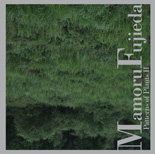 First released in 1994, Tetsu Inoue's debut album Ambiant Otaku was limited to 1000 copies, yet made a significant splash in the fledgling minimalist techno community. Reissued in 2003, the album is now considered a classic, and original copies are highly collectible. Spanned by five lengthy compositions ranging from 10 to 18 minutes, Ambiant Otaku is a gentle space cruise through pillowy nebulae of sound. "Karmic Light" opens the album with a sparkling, hazy mire of enveloping drones, overtone sweeps, and polyrhythmic beeps. Light percussion gives the first section of the piece somewhat of a driving feel, but about halfway through, the texture becomes suddenly rarefied, and the listener simply floats, as though suspended in honey.
First released in 1994, Tetsu Inoue's debut album Ambiant Otaku was limited to 1000 copies, yet made a significant splash in the fledgling minimalist techno community. Reissued in 2003, the album is now considered a classic, and original copies are highly collectible. Spanned by five lengthy compositions ranging from 10 to 18 minutes, Ambiant Otaku is a gentle space cruise through pillowy nebulae of sound. "Karmic Light" opens the album with a sparkling, hazy mire of enveloping drones, overtone sweeps, and polyrhythmic beeps. Light percussion gives the first section of the piece somewhat of a driving feel, but about halfway through, the texture becomes suddenly rarefied, and the listener simply floats, as though suspended in honey.The rest of the album maintains this "drifting through clouds" consistency, more often than not without any percussion, but there is a surprising amount of musical and emotional variety from track to track, and even within single tracks. "Low Of Vibration" sports some unbelievably deep bass rumbles beneath soft washes of keyboard; "Ambiant Otaku" with its short, repetitive melodies has a slightly sinister edge; the beautifully serene "Holy Dance" builds gradually from smooth drones to include brushy percussion and echoing wah guitar. The album closes with "Magnetic Field", a gorgeous expanse of reversed synth melodies and silky electronic murmurs.
Now more than 15 years old, Ambiant Otaku has held up extremely well, largely due to its very tasteful, modern sound palette and subtle compositions. Since its release, Tetsu Inoue has gone on to become a major figure in experimental electronica, now with nearly 20 albums under his belt, including the glitchy, Oval-esque Fragment Dots (Tzadik Records, 2000), and collaborations with Bill Laswell and Taylor Deupree. For fans of the expansive soundscapes of Steve Roach and Brian Eno, Ambiant Otaku remains essential listening.
Download
Purchase the Reissue from Amazon




